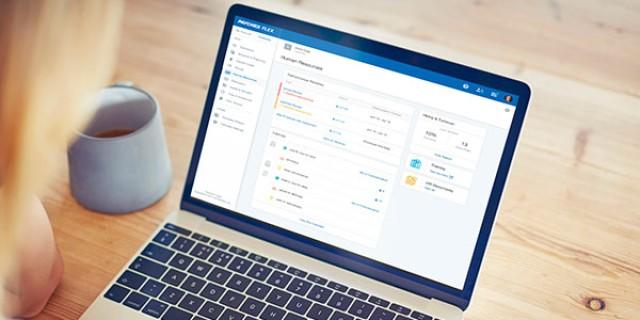- Human Resources
- Article
- 6 min. Read
- Last Updated: 02/21/2025
What Is Form I-9?: What You Need To Know About the New Form and Requirements

Table of Contents
Update: The U.S. Citizenship and Immigration Services (USCIS) extended the expiration date of the Form I-9 issued on Aug. 1, 2023. The form with the edition date of 08/1/2023 can be used until the expiration date listed on the form, either 07/31/2026 or 05/31/2027.
Employers must update their electronic Forms I-9 systems to the form with the 05/31/2027 expiration date by July 31, 2026.
Changes to the form include a new order of sections in an effort to make the process of completing the form simpler. The form also has a checkbox for employers enrolled in E-Verify to be marked when identity and employment authorization documents have been examined remotely through an alternative procedure the Department of Homeland Security (DHS) authorized.
Employers must meet some essential compliance requirements when hiring new employees. Forms (paper or digital), including Form I-9, must be completed and retained for each new employee.
Federal law requires employers to receive and maintain a completed Form I-9 for every new employee. Employers may also need to provide access to completed Forms I-9 during inspections conducted by the Department of Homeland Security, the Department of Justice, the Department of Labor, or other government agencies.
The U.S. Citizenship and Immigration Services (USCIS), an agency of the Department of Homeland Security, requires the completion of the Form I-9, Employment Eligibility Verification, to establish that an employee is eligible to work in the U.S. In addition to proving employment eligibility, Form I-9 is used to verify an individual's identity by requiring the individual to provide the employer with acceptable documentation as evidence of identity and employment authorization.
The USCIS updates the Form I-9 periodically, so employers should ensure they are using the most current version of the form available on the USCIS website.
What Is Form I-9 Used For?
As noted above, the Form I-9 is used to verify the identity and employment authorization of individuals hired to work in the U.S. Federal law requires employers to hire only individuals who are legally permitted to work in the U.S., including:
- U.S. citizens
- Non-citizen nationals
- Lawful permanent residents
- Noncitizens authorized to work the United States
To comply with this requirement, employers must inspect documentation presented by the newly hired employee to confirm the identity and employment authorization. The Form I-9 documents this inspection, which businesses must complete and retain for each employee.
Who Must Complete Form I-9?
As of November 1986, all employers in the U.S. are responsible for ensuring that newly hired employees complete a Form I-9, regardless of citizenship status. The process requires participation by both the employee and employer to properly complete the form correctly.
- By signing this form and providing acceptable documentation (as noted on the Form I-9 Lists of Acceptable Documents), an employee confirms their identity and that they are authorized to be employed in the U.S. They present government-issued identification to the employer to prove their identity and eligibility to legally work in the U.S.
- After inspecting the acceptable documents, employers sign the Form I-9, attesting to the fact that the documentation provided appears genuine, and they retain the completed form. Employers are required to accept whatever forms of identification prospective employees present, provided they are on the lists of acceptable documents.
- Mandating that employees provide certain documents on the list (such as a driver's license and Social Security card) but refusing others that the list classifies as acceptable can be considered a discriminatory hiring practice.
The USCIS defines "employer" as all employers, including recruiters and fee-based referrers, who are agricultural associations, agricultural employers, or farm labor contractors. An "employee" is defined as anyone who performs labor or services in the U.S. for an employer in return for wages or other remuneration.
Volunteers, unpaid interns, independent contractors, or those engaged in some types of casual domestic employment (such as babysitters) are not required to complete a Form I-9. However, employers should ensure accurate classification of workers to avoid potential violations.
Where To Get Form I-9
You can download the Form I-9 and instructions from the USCIS website. There, you will also find related documents, including instructions on how to download and complete the form, as well as versions of the Form I-9, Form I-9 Supplement, and instructions in Spanish.
Within the instructions is a link to the M-274. This compendium of I-9 compliance information and instruction is offered to help employers further understand their employment eligibility verification obligations.
How Do You Fill Out Form I-9?
The Form I-9 has two sections and a Supplement B, and employers must provide instructions on how to complete the form. A newly hired employee and the employer complete their respective sections.
Section I is to be completed by the employee, while Section II and Supplement B (formerly Section III) are completed by the employer or the employer’s authorized representative. Supplement B is used for re-hires and re-verifications when the employer chooses not to complete a new Form I-9.
Employers must provide I-9 instructions on how to complete the form. For additional help and instructions, check out the employer handbook (M-274).
What Documents Are Needed To Complete Form I-9?
A single document may suffice to establish employee identity and employment eligibility, such as a U.S. passport or permanent resident card. Sometimes, an employee may need to present two documents, such as an original Social Security card (not a copy) and a valid driver's license. It is up to the new employee to choose which document(s) to provide — the Form I-9 Instructions detail which documents are acceptable — but the employer must examine these documents to determine whether they reasonably appear to be genuine and relate to the employee.
Suppose the employee's document(s) do not reasonably appear to be genuine or to relate to the employee? In that case, an employer must reject the document(s) and provide the employee with an opportunity to present other documents from the Lists of Acceptable Documents.
Form I-9 Storage and Retention
According to USCIS, employers must obtain a completed Form I-9 for each newly hired employee. The completed form must be retained while the employee works for your company and for a specified amount of time after your business no longer employs them. This requirement applies even when a new hire decides to leave employment soon after beginning there.
After employment ends, the employer must retain the employees’ completed Form I-9 (and copies of documentation if applicable) for either three years after the date of hire or one year after the date employment ended, whichever is later. Guidance can be found on the USCIS website.
Federal regulations mandate Form I-9 retention requirements. If the employer makes copies of the documentation presented by the employee when the Form I-9 was completed, those copies must also be retained under the same retention guidelines.
Completed Forms I-9 may be retained in paper or electronic format. Employers are encouraged to review the Department of Homeland Security electronic storage regulations to avoid fines and penalties.
What If an Employee Doesn’t Fill Out Form I-9?
Employers may be subject to potentially severe consequences for failing to obtain and retain completed Forms I-9 from new hires. U.S. Immigration and Customs Enforcement can request Form I-9 for each current employee as part of its Notice of Inspection (NOI). They can also ask for Form I-9 for a terminated employee within the retention period. The process, initiated by serving an employer with a NOI, requires providing the requested Form I-9 document in as few as three business days. Failure to do so, and even minor paperwork mistakes, might result in penalties.
In the case of an audit, in addition to the Form I-9, an employer may be asked to provide supporting documentation that may include a copy of the payroll, a list of current employees, articles of incorporation, and business licenses.
Substantive and uncorrected technical violations associated with Form I-9 compliance can range from a minimum of $281 to as much as $2,789 per Form I-9 for a first offense. Penalties increase with subsequent offenses. Other monetary penalties are steeper, including for "knowingly hiring and continuing to employ" violations.
Employers should adhere to the requirements for use, completion, and retention related to Forms I-9 to mitigate potential fines, penalties, forfeitures, and debarment of federal contracts.
Self-Audits for Form I-9 Compliance
A thorough review of your Form I-9 procedures and performing a self-audit of completed Form I-9s can help employers avoid potentially costly errors in the future. If a mistake is found during your self-audit, the USCIS provides guidance on correcting forms.
According to USCIS, the most common errors include the following:
- Missing employee name or identification information
- Employee failure to sign and date form
- Employer failure to specify identification documents reviewed
- Missing employer information or signature
When an error is discovered in a current employee’s completed Form I-9 Section One, the employer should request that the employee make corrections. The employer should also correct errors in Sections Two or Three.
Corrections can be made by drawing a line through the incorrect information. Then, the correction should be made, along with an initial and date. If there are more errors, the applicable section of the form may be amended and attached to the original form. A note should be included in the file regarding the reason you made changes to an existing Form I-9 or completed a new Form I-9. Employers can visit the USCIS website for additional guidance.
I-9 vs. W-9: Are They the Same?
The number of numbered forms that employers and employees have to complete and retain can create confusion, especially the similar-numbered ones. For example, a Form I-9 and a Form W-9 are not the same document.
- A W-9 is an IRS tax filled out by third parties, such as independent contractors who provide services to businesses, at the request of the business.
- An I-9 is used to establish that an employee is eligible to work in the U.S. In addition to proving employment eligibility, Form I-9 is used to verify an individual's identity by requiring the individual to provide the employer with acceptable documentation as evidence of identity and employment authorization.
Failure to complete the correct form to verify employment eligibility may result in unwanted financial penalties.
Form I-9 Compliance Is a Critical Part of Onboarding
Ensuring a completed Form I-9 should be a mandatory step when employers bring new hires on board. To help you ensure that you're meeting this and other regulatory requirements during the onboarding process, an HR consultant can review your current hiring procedures and offer support as needed. Paychex also provides employee onboarding software that facilitates the time it takes to complete the Form I-9 and other processes.
For more information, consult the USCIS website to download a copy of a Form I-9, instructions and follow updates as they happen. Should you need assistance with Form I-9 compliance, get help from an HR professional.
Additional Resources
FAQs from U.S. Citizenship and Immigration ServicesTags







